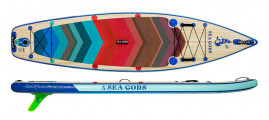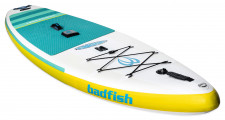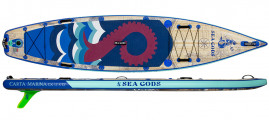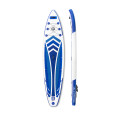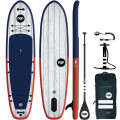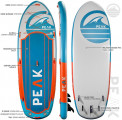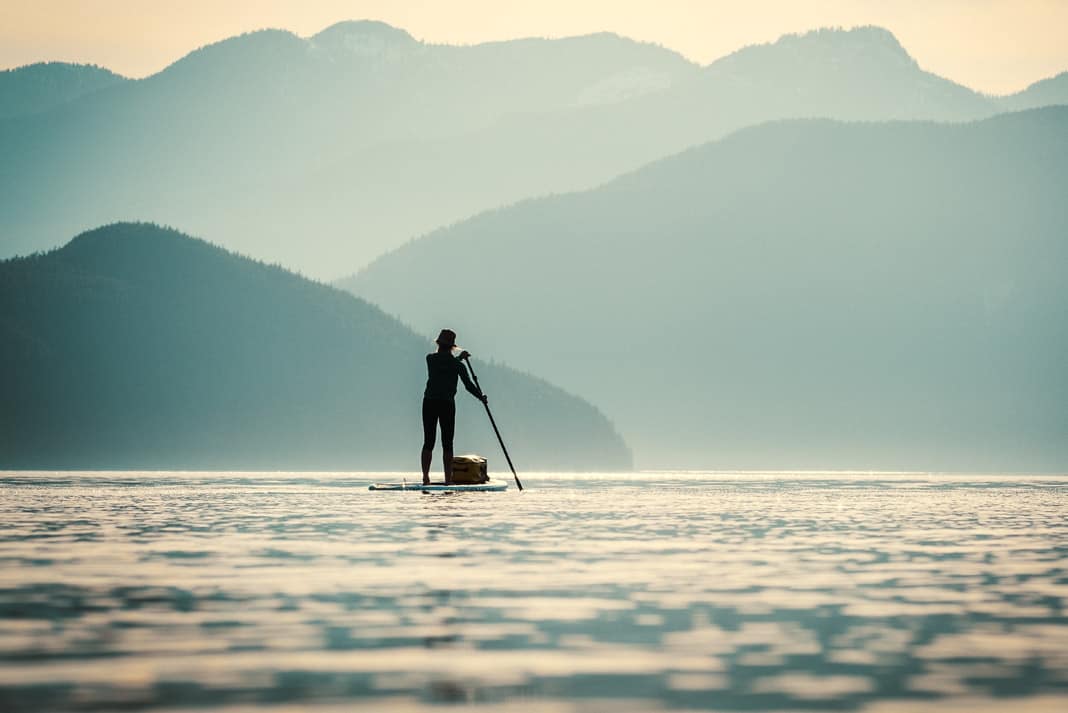Whether you’re a new or experienced paddler, a touring paddleboard is one of the best investments that you can make to expand your paddling adventures and take your outdoor pursuits to the next level. Picture this: enjoying new paddling experiences further away from shoreline, the satisfaction of your paddleboard tracking straighter through the water without switching sides as often, the nose of your board gliding effortlessly though calm conditions and then cutting through the waves when the wind picks up…. This is what awaits you with a touring standup paddleboard.
Touring standup paddleboards come in both inflatable and hard board models and are a great choice for the majority of generalist paddlers, as well as paddlers who currently use an all-around style board and are ready to up their SUP game by paddling further, faster and more efficiently.
Touring boards are also perhaps the biggest draw to entice touring kayakers into trying stand up paddleboarding. Designed to be outfitted with gear for your adventures, touring boards open up possibilities for day tripping, SUP camping and for paddling further distances on the water.
Just like canoes and kayaks, touring paddleboards are capable of covering hundreds of kilometers—just ask expedition paddlers Bruce Kirkby and Norm Hann, who use their touring boards to paddle among the remote wilderness of British Columbia’s Great Bear Rainforest and along unforgiving coastlines.
If you’re new to the world of paddleboarding, welcome—you’re in the right place. This article will teach you about touring paddleboards, offer recommended boards and reviews and will help you determine if a touring paddleboard is the right choice for you.
Before you begin shopping for SUPs we recommend you jump down to our Buying Guide for guidance on how to select a touring standup paddleboard and answers to the most commonly asked questions about touring paddleboards.
Top picks: Best touring standup paddleboards for 2024
The following touring paddleboards have received the highest star ratings by reviewers in our Paddling Buyer’s Guide. See and review all touring standup paddleboards here.
Best Touring Paddleboards
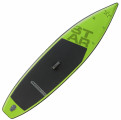
Photon 11.6
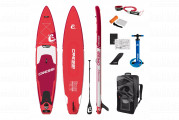
Fury
Shop touring paddleboards
Touring paddleboards come in many shapes and sizes, with each variation being better or worse suited to different paddling styles and environments (such as ocean or flatwater).
Touring paddleboard performance ranges from race touring paddleboards, which are designed for speed, to expedition touring paddleboards, which are designed for efficient performance while also being able to secure and haul camping gear.
The market is full of options, which can leave you with many exciting choices for a touring paddleboard. The task of refining your choices will be much easier if you have a sense of the environment that you’ll be paddling in, what your paddleboarding goals are and whether you are seeking an inflatable or a hard board SUP.
We’ve created a Paddling Buyer’s Guide where we’ve laid out these categories for you so you don’t get lost down a rabbit hole of research. In the Buyer’s Guide you can find every touring paddleboard on the market, including specs, prices, reviews and where to buy.
Shopping for a used touring paddleboard?
Whether you’re environmentally concerned, budget conscious or want a higher-quality board at a lower price, shopping used is a great way to add a touring paddleboard to your quiver. It is very common for standup paddlers to buy their first race board second-hand when they are starting out in the race scene.
Used touring SUPs can be purchased from a shop at an end-of-season demo sale or through private sales, but no matter where you purchase it is important to consider the following when shopping for a used touring paddleboard.
First, use the same thinking that you would apply to buying a new board to ensure that you’re getting the right board for you rather than getting sucked into what looks like a good deal. Only then, start looking over the board with a fine-toothed comb to look for holes or repairs.
Algonquin Outfitters paddlesports buyer Keele Wegner recommends looking for dings in the nose and spine along the bottom of the board and noting if any damage was left unaddressed or repaired and what the quality of the repair is.
Wegner suggests, “Find issues and see if they’ve been addressed. Damage is only still an issue if it hasn’t been addressed.” An issue being addressed means that the repair is properly done, the integrity of the paddleboard has not been compromised and the repair is such that it will not allow water to enter into the board.
Additional places to look for cracks, dents and cosmetic scratches are the rails, fin, fin box and deck pad. Very small dents that don’t break the outer shell of the board and cosmetic scratches are not a functional issue and are pretty much expected on the board after the first paddle and likely won’t require any repair. Of course, they bring the price of the paddleboard down and you may be able to get a better deal on a paddleboard that very obviously has been used.
Bigger cracks or holes in the board should have been repaired immediately by the current owner prior to purchase. These will certainly lower the price of the standup paddleboard and create more room for negotiation on the sale price. Do not purchase a used touring paddleboard that has large cracks or any holes that may have allowed water to infiltrate.
If you come across a hole on a hard touring board it’s a good idea to pick up the board by the handle and locate the center of gravity. If the board is nose- or tail-heavy it may indicate that water has gotten into any holes. This can feel like a nightmare to handle if you are portaging or carrying the board often and is not an easy fix. Don’t spend money on a board that has noticeable water in it as you might not be able to get the water out and could potentially damage the board trying.
Touring paddleboards can sometimes be like the Mr. Potato Heads of the SUP world, with board modifications such as additional tie-downs being common. It’s important to note any modifications and if they affect the integrity of the board. Also look for wear around existing tie-down locations and handles, as well as the quality of the bungee cords.
It’s always a good idea to chat with the seller to learn about the board’s history. Ask questions to find out if it was a rental board, if it was used ruggedly, the reason for selling, as well as what they liked and disliked about the board. Asking these questions may give insights into if it’s the right board choice for you.
If traveling to meet the seller, ask them to send a video of the entire board including any photos of damage, repairs or modifications so that you can have a really good idea of the condition of the board prior to committing to meeting up, after which point it can be harder to talk yourself out of an unwise purchase.
Wegner also advises buyers to do research on the history of the brands and their development of touring board models to see how the designs have changed over time. He recommends a board like the Boardworks Raven as a tried, tested and true design and cautions against buying based on looks, “Graphics should be last on your mind”.
Expedition guide and founder of SUP Norway, Titus Kodzoman, exclusively uses inflatable touring paddleboards for his expeditions and offers the tip that it’s much better to buy a top second-hand brand iSUP than a new cheap board. “Well constructed iSUPs can last years and stay stiff, serviceable and give you much better value for your money.”
Kodzoman also recommends shopping for a white or lighter-coloured paddleboard. “If you leave a dark-coloured board in the sun and then touch it, it will be super hot. This represents UV and heat absorption that will destroy the glue and drop-stitch bonding. UV and heat absorption promote delamination and degradation.”
For more tips on what to look for when selecting a used paddleboard, read our article How To Buy A Used Paddleboard.
Touring paddleboard buying guide
If you’re considering if a touring paddleboard is the right style of paddleboard for you there are a few key guiding questions that can help you to suss out the answer. Consider the following:
- Do you plan to use your paddleboard for camping?
- Will you venture out on day trips for many hours at a time?
- Is it important to you that your paddleboard is efficient, has good glide over the water, and can easily be paddled in a relatively straight line?
- Would you like to have a paddleboard that has the capacity to carry gear on board?
If you’ve answered yes to one or more of the questions above — great, it sounds like a touring paddleboard is a good fit for you. Let’s go through a few more questions to find the best touring paddleboard to suit your needs.
Size
An important consideration is the size of a touring paddleboard. You will generally need a longer paddleboard, likely 14 feet, if you answer yes to any of these questions:
- Will you be using the touring paddleboard for multi-day paddles, camping trips, expeditions or long-distance racing?
- Will the weight of the paddler and gear on board exceed 250 lbs?
As a guideline, the longer the distance you will be paddling, the longer the board you will require for efficiency in glide and speed. Similarly, the more weight on the board, the more volume you will require from a paddleboard, which is generally an increase in the length of the board. Head to Touring Paddleboard Size below for more guidance on the length, width, weight and maximum weight capacity of a touring paddleboard.
Material & construction
Now we’ll ask some questions to help you choose between a hard board and an inflatable, and also between material types.
- Is it important that your touring paddleboard is lightweight?
- Is it important that your touring paddleboard is durable?
- Will you be traveling with your touring paddleboard and would like it to be convenient for storage and transportation?
If you’ve answered yes to the above questions then a good quality inflatable touring paddleboard might be the best bet for you. They are typically lighter than a hard board, they pack up easily so that you can even fly them on a plane to your next paddle destination, and are generally very durable.
On the other hand, a hard touring paddleboard tends to perform better than an inflatable, so if speed is your most important factor and you plan on racing, go with a hard board. Hard boards in a carbon fiber material are your best bet for lighter weight although they come with a hefty price tag and are more susceptible to damage from dings and bumps.
Another option is a fiberglass and epoxy touring board, which will have a bit of added strength and won’t dent your pocket quite as much as the carbon fiber models. Fiberglass paddleboards typically weigh more and cost more than inflatable paddleboards and although hard boards are more of a pain to transport than an inflatable they are ready to paddle whenever you are.
Price
The price of touring standup paddleboards can range from roughly $1,200 CDN for a mid-range 11.5-foot inflatable to upwards of more than $3,000 for a 14-foot carbon fiber touring paddleboard. They are generally a bit more costly than an all-around paddleboard as they are shaped to cut through the water and have added features like additional tie-down points for gear storage.
When searching for a touring paddleboard your budget will dictate the quality of the manufacturing of the paddleboard as well as the materials and weight of the board.
For entry-level or intermediate paddlers who would like a touring paddleboard for day excursions and the odd camping trip, you could find a decent-quality touring SUP for around $1,300-$2,000, with inflatables at the lower end of the price range. Those looking to go fast or use a touring paddleboard for expeditions or racing should expect to invest over $2,000 for your adventure machine.
Still have questions? We have answers.
Here you’ll find some frequently asked questions and information to consider when buying a touring paddleboard. We imagine that you might be wondering, “What should I look for in a touring paddleboard?” It’s all covered below.
-
What is a touring paddleboard?
A touring paddleboard is a stepping stone between all-around boards and race boards. A touring paddleboard has a stream-lined design with long-distance touring and performance in mind. Long-distance touring is a relative idea and could range from 10 km to hundreds of km, however, you’ll find an advantage to using a touring paddleboard instead of an all-around board if you are traveling any distance at all.
Touring paddleboards are shaped with a pointed nose, are sometimes referred to as pointy boards and often have a displacement-style hull. A displacement hull means that the bottom of the board is rounded, similar to a sailboat, so that the paddleboard can cut through water for a stable and smooth ride, rather than skipping across the surface like a surfboard.
Touring boards excel at long-distance paddles and day tripping as well as camping trips. They typically have equipment tie downs at the front and/or back of the board for securing gear to the board. Touring standup paddleboards are designed for efficient paddling, so that they glide further with each stroke, and offer excellent tracking, meaning that the paddleboard stays in a relatively straight direction with each stroke.
-
Touring paddleboard vs all around paddleboard
Ah yes, the most common question of them all—what is the difference between a touring paddleboard and an all-around paddleboard. And which should you choose? To understand the differences, let’s break the two categories down a little further.
With an all-around board you can expect a more rounded surf-style shape, good stability and oftentimes added thruster fins on the bottom of the board for better tracking. Another difference is that all-around SUPs have a planing hull, which means that the board is flat on the bottom and sits on top of the water, creating a bumpier ride as the board glides over the tops of waves rather than through them.
All-around boards are not designed for speed and are often the choice for short paddles, SUP yoga, surfing and for messing around on while at the cottage. An all-around board could be used for day paddles or overnight camping, especially if there are equipment tie-down bungees on the board, but it won’t be the most efficient choice of paddleboard for these scenarios.
The touring paddleboard is like the athletic sibling to the fun loving all-around board. Touring boards are more hydrodynamic and offer increased efficiency with more glide and straighter tracking. They have a displacement hull, which pushes water around the sides of the nose of the board, and perform better in windy and wavy conditions. Touring standup paddleboards are the best choice for you if you want to explore a little further, take your fitness on the water, go SUP camping or begin to race.
You could try SUP yoga on a touring paddleboard but they’ll likely land you in the water a few more times than if you used an all-around board—not so Zen. Touring paddleboards are also a good choice for day paddles and the cottage if all the paddlers who may use the board have good balance, or don’t mind getting wet.
Algonquin Outfitters paddlesports buyer Keele Wegner sells hundreds of boards a season and starts by asking customers, “What do you want to do on the board?” Wegner describes all-around boards as “a floating dock with a fin, perfect for Instagram selfies.” He recommends choosing a touring paddleboard if you are concerned with efficiency. “They go further with each paddle stroke, and stay straighter,” says Webner.
He cautions not to get caught up in the word touring, suggesting instead the language of ‘flatwater’ or ‘displacement’ boards to help customers see that all-around boards are better suited for surfing and that most paddlers are better off on a touring paddleboard if they intend on traveling even short distances.
So, what do you want to do on the board? It is important to consider your primary and secondary uses of the board. For example if you plan to do mostly day paddles that are a few kilometers long and want to race recreationally every now and then your best bet is likely a touring paddleboard.
If your primary use is SUP yoga and you might overnight camp at a nearby site once a year then perhaps an all-around board with bungee tie-downs would suit your needs best. Consider how both styles of board might inhibit or enhance your desired board use and experiences in order to make the most informed decision.
Since most paddleboards are designed for specific activities in mind, you will often see stand up paddleboarders expand their collection of paddleboards over time, with multiple styles of boards to best suit their needs on any given day.
Touring boards are often more expensive than all-around boards, so that may factor into your decision of which type of board you choose to purchase.
-
How much faster is a touring SUP?
A touring paddleboard is certainly a bit faster than an all arounder. If you were to exert the same effort on an all-around SUP and then again on an equivalently sized touring SUP you should expect the touring SUP to come out faster every time.
To give a general sense of speed—in an hour the average paddler may travel about 3–5 km on an all-around board and perhaps 4–7 km on a touring board at a moderate pace. Racers would tend to cover something more like 8–12 km in an hour on a race touring paddleboard.
There are many factors that determine the speed of a paddleboard including the length of the board (which dictates the glide), the width of the board (there is a trade off between stability and speed), the volume and the nose shape. In general, the longer and narrower the board, the faster it will be. Hard boards also tend to be faster than inflatable board designs.
Additional factors such as the wind speed, water conditions, current, distance of the paddle, and both the skill and strength of the paddler play a role on the overall speed on any given day.
-
Touring paddleboard size
Touring paddleboards typically range from 11 feet to 14 feet in length. The most important specifications to consider when shopping for a touring paddleboard are the length, width, weight, and maximum weight capacity of the board. Let’s look further into the four most important specs.
Length: In order to benefit from efficiency and glide attributes, it is recommended that you stick to a touring paddleboard that is at least 11 feet long. Fourteen-foot boards are common in racing, expedition paddling and for larger paddlers. Keep in mind that the longer the board the more challenging it is to maneuver on the water. The most common length of touring paddleboard is 12.5 feet.
Width: The width of the board affects the stability and is generally between 26–34 inches, with a larger width offering greater stability. Race touring boards trade stability for speed and push the limits of a narrow width. The happy place for stability on touring boards is generally 32 inches.
Weight: The weight of the paddleboard will come into play when you are transporting the board, whether you are carrying it to your vehicle and lifting it on top or are portaging the touring paddleboard while on a camping trip. The weight of the board is dependent on the size and volume of the board as well as the material that it’s made out of. Touring paddleboards generally weigh between 24 and 34 pounds, with inflatable paddleboards and carbon fiber paddleboards being lighter, making them easier to lift and transport. A few extra pounds on a touring paddleboard isn’t as noticeable for performance in the water as it is for the impact it has on carrying the board.
Maximum weight capacity: The maximum weight capacity of the board is related to the volume of the board. It’s the upper limit of what the board is designed to float while maintaining performance. Always choose a board with a higher maximum weight capacity than your actual weight. Ensure to add in some buffer room—you don’t want to be right at the upper edge of the weight capacity as paddling will become more challenging and the board may rest too low in the water. Remember to factor in any added weight of camping equipment or kids and dogs that may be tagging along with you out on your paddles.
Touring paddleboard reviews
While “Try it before you buy it” is always sound advice, it may not always be feasible, or perhaps you just like to live life on the edge. Even so, how do you decide which paddleboards to try? How do you find out which performed well and left paddlers seriously happy with their purchase? Through lots of research and from reading reviews, of course.
If you want to hear from the people out paddling the equipment that you’re considering investing in, then take a peek at these touring standup paddleboard reviews. The proof is in the paddling, after all.



